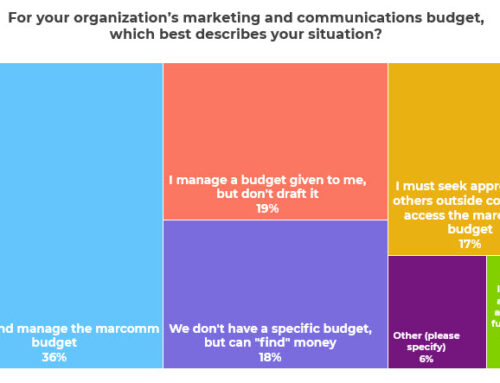In previous posts, I’ve shared with you the twelve most common nonprofit marketing and communications goals and the twelve most common nonprofit marketing and communications strategies.
Today let’s talk about the types of objectives you should have in your communications plan.
Objectives are the SMART steps you take to achieve a strategy, and at Nonprofit Marketing Guide, we prefer to define SMART as Specific, Measurable, Achievable, Resourced, and Time-Bound. If you focus on Measurable and Time-bound, you are usually in good shape with Specific. Achievable and Resourced are there to remind you not to make up stuff that you don’t have the capacity to implement.
That said, SMART is not really enough guidance on what a nonprofit communications team should consider an objective.
So I’ve come up with yet another list for you.
As a refresher, common goals — the broad outcomes you seek via communications — include engaging your community to keep people inspired and active in your work, raising awareness of issues to educate people on your cause, advocating on your issues, brand building/reputation management, and fundraising from individuals.
Common strategies — the marketing approaches to achieve your goals — include permission-based marketing, content marketing, event marketing, general advertising, and search marketing.
Here are a dozen ways to think about objectives:
- Newly joining, subscribing, or following (e.g., increase newsletter subscriptions by 20% this year)
- Expressions of loyalty, including retention or renewal (e.g., maintain a 75% donor retention rate this year)
- Participation levels, such as registrations, donations and RSVPs (e.g., sell out 90% of the workshops this year)
- Financial gains or savings (e.g., increase the percentage of race revenue raised via peer-to-peer fundraising by 20%)
- Increased levels of influence or share of conversation (e.g., get invited to speak at 5 events this year)
- Increased demand or desire for something (e.g., increase appointment requests by 30% next quarter)
- Change in knowledge or understanding (e.g., 75% of beginners move to the intermediate level in 6 months)
- Change in tone, sentiment, attitude or preferences (e.g., the majority of social media comments on our profiles are positive or neutral this year)
- Increased preparedness or empowerment to act (e.g., 70% of petition signers continue to open educational emails six months later)
- Change in behavior (e.g., 50% fewer students use inappropriate language this semester)
- Increased satisfaction (e.g., raise the Net Promoter Score for the program to +60)
- Expressions of trust (e.g., three new organizations agree to partner with us on the new project)
As you can see, these are generic categories that you’d need to customize for your nonprofit.
In many cases, in addition to adding the Measurable and Time-bound elements, you also need to add some reference to the who — your participants, supporters, or influencers — and sometimes the what you are communicating about — your messaging or call to action.
The tactics you use (the channels or tools) can also influence how you phrase your objectives, although I caution you against only using objectives that are directly tied to a specific tool or communications channel. Ideally, you are using multiple tools or channels to achieve an objective.
Let me know what you think about this list of marketing and communications objectives in the comments. Does it help you think differently about your objectives?
Want more? Join me for Communications Planning that Works: Getting Your Goals, Strategies, Objectives, and Tactics Right in 2019, a brand-new two-part webinar series in January.





